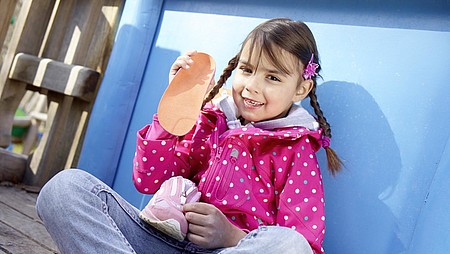What is a pes planus?
In pes planus, the entire sole of the foot lies against the ground, which makes the feet appear “flat”. This is why it’s also known as “flat feet”. Numerous foot misalignments are combined in this condition: a fallen longitudinal arch (fallen arches), a heel bone that bends in (valgus foot) and the splaying of the midfoot bone when walking (splay foot).
Causes and risk factors for flat feet: How does pes planus develop?
Alongside congenital deformities, above all muscular deficits and weaknesses of the capsular ligament system lead to pes planus. This can mean that the longitudinal arch of the foot can no longer fulfil its function as a shock absorber. In a healthy condition, the longitudinal arch and transverse arch of the foot distribute the entire body weight over these three main load points:
- Heel
- Big toe
- Balls of the foot
Weak foot muscles and additional strain – such as due to jogging or excess weight – can flatten out the longitudinal arch: The foot lies more and more against the ground. The ligaments cannot hold the heel bone in its natural position any more. This is why the heel bends outwards. At this stage, it is referred to as pes valgus (skew foot and fallen arches). If this remains untreated, pes planus can also develop: With every step the foot makes, the entire longitudinal arch is pressed down flat.
Risk factors that promote the development of pes planus
Excess weight, reduced elasticity of the tendons, weak connective tissue, unstable ligaments and insufficiently trained foot muscles make pes planus more likely to develop. Examples of additional risk factors include:
External factors, such as
- Unsuitable shoes
- Overstrain through standing and walking for a long time
Sport that puts the feet under heavy strain, such as
- Sports which involve intense jumping such as basketball and volleyball
- Intensive running sports such as jogging, speed-walking and hiking
- Sports involving fast changes of direction such as handball and football
- Sports involving backwards stop-and-go movements such as tennis, squash or badminton
Symptoms and signs of pes planus
Even if there are no symptoms with pes planus at first, greater strain can lead to pain, particularly in the sole of the foot, but also in the knees or in the lumbar spine.
Visible signs include:
- The foot arches sink downwards (fallen arches).
- The heel bone buckles inwards (valgus foot).
- The metatarsal bones spread outwards (splay foot).
Treatment of pes planus – what can you do about it?
Individually fitted orthopaedic foot orthotics support therapy and can offer correction by lifting and supporting the longitudinal arch. Thanks to the defined heel support, the position of the heel bone is optimised. Wearing orthopaedic foot orthotics helps to balance out foot misalignments. They also promote healthy posture and can alleviate pain.
Foot misalignments can be identified by a doctor or an foot orthotics specialist by examining the footprint or analysing the foot when walking and standing. The specialist will select the orthopaedic foot orthotics according to the symptoms, shoe type and area of application. The foot orthotics will then be custom fitted.
If knee pain or other accompanying symptoms exist as a result of flat feet, your doctor will advise further treatment options.
Strengthening foot gymnastics for pes planus – exercises for the feet
In addition to therapy with foot orthotics, we recommend that you train your foot muscles regularly. We’ve put together several exercises to help you strengthen your feet for long-term benefits.
Orthopaedic foot orthotics by medi
Find out more information about the orthopaedic foot orthotics from medi here.
Highlights
Product tip
Diagnosis & treatment
Health personnel will make the diagnosis and can prescribe orthopaedic foot orthotics, e.g. from medi if necessary.
Your medical retailer will fit them individually for you.







